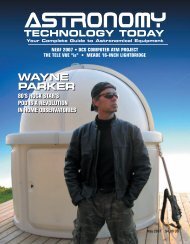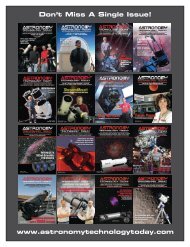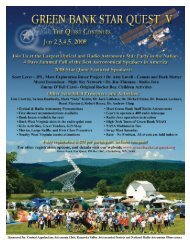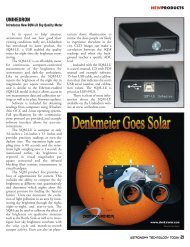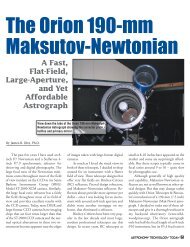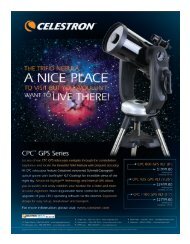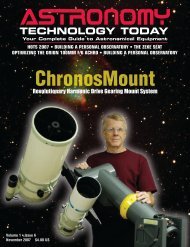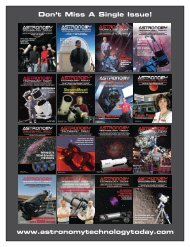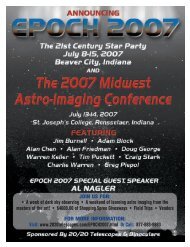magnilux - Astronomy Technology Today
magnilux - Astronomy Technology Today
magnilux - Astronomy Technology Today
Create successful ePaper yourself
Turn your PDF publications into a flip-book with our unique Google optimized e-Paper software.
A 3D CAD PRIMER<br />
Image 1<br />
focal-length value will rise. Click on that<br />
and change the value from 120 inches to<br />
60 inches and, when you hit the return<br />
key, the mirror geometry will still have the<br />
parabolic profile, but of a much faster f/5<br />
mirror.<br />
And, if you have assigned a density<br />
value of Pyrex to that mirror (0.0805 per<br />
cubic inch), you will see the weight go<br />
down as a consequence of the deeper<br />
sagitta. And, if the mirror just happens to<br />
be nested in a telescope assembly, you will<br />
see the center of gravity (CG) shift forward<br />
to a new position – all automatically<br />
and without having to use a calculator!<br />
Builders of Dobsonian telescopes, please<br />
note; never again need you guess where<br />
your bearings should be or have to add or<br />
remove lead ballast from the mirror box –<br />
not if you designed it in a 3D solid modeler<br />
and built it as you designed it! The<br />
CG will be where the software said it<br />
would be.<br />
If your dream scope is going to reside<br />
in a fork mount, again, you must know<br />
where it will balance. If the tube is 30<br />
inches long and the CG is about 10 inches<br />
forward of the primary mirror, will the<br />
back end of the tube clear the base of the<br />
fork when it’s swung No How much<br />
longer must the tines of the fork be in<br />
order to swing the OTA without interference<br />
Or, how much ballast must be<br />
added to move the tube to clear and<br />
Image 2<br />
where<br />
The scrap bins of the world are filled<br />
with the guesstimates that failed to work.<br />
Material can be expensive. Your time is<br />
too. Invest time in designing it properly<br />
before you step into the shop and all these<br />
concerns cease to be. The consequences,<br />
for even the most complex structures, are<br />
faster construction, fewer makeovers, and<br />
more certainty with no surprises.<br />
Faster or Slower<br />
In the beginning, using 3D CAD<br />
software will not necessarily get your<br />
scope built faster. It will likely be a better<br />
design with fewer surprises, but the time<br />
invested while seated at the computer has<br />
to be considered as part of the dues<br />
that must be paid. However, it is fun and,<br />
after so many years of designing optical<br />
systems, I have accumulated a library<br />
of virtual parts that makes the design<br />
process both faster and easier. In addition<br />
there are user groups who share part<br />
geometry with others. That speeds<br />
Image 3<br />
things up too.<br />
Let’s say I need a model of a secondary<br />
mirror with a minor axis (MA) of<br />
three inches and one-half inch thick, but I<br />
don’t have one. I simply copy an existing<br />
model of a two-inch mirror to a new file,<br />
open that one, click on the thickness and<br />
click on the MA, and change their values<br />
– within seconds I have the new mirror.<br />
But it gets better! If the secondary fixture<br />
is linked to the mirror it holds and I<br />
change the size of the mirror, the fixture<br />
updates too! And, so do all the mass properties!<br />
Many manufacturers, anxious to<br />
Image 4<br />
make more sales, are now offering free 3D<br />
models of their parts. You can log on to<br />
McMaster-Carr’s web site, as one example,<br />
and download free 3D solid models<br />
of many parts for use in virtually any<br />
CAD program. I rarely design commercially<br />
available parts any more. I simply<br />
download the geometry from the appropriate<br />
Internet site. The knob shown in<br />
Image 4 is in my designs for collimation.<br />
It’s a solid model and a download that I<br />
can purchase, or not.<br />
If this trend continues, you can<br />
expect eyepiece manufacturers to offer<br />
simple 3D CAD solid models of their eyepieces<br />
along with their mass properties.<br />
They do not appear to be available yet, so<br />
when it came time to see how a 17-mm<br />
Wide-Angle Vixen Lanthanum affected<br />
the balance of a scope, I simply reverse<br />
engineered a real one myself. I only had to<br />
60 <strong>Astronomy</strong> TECHNOLOGY TODAY



